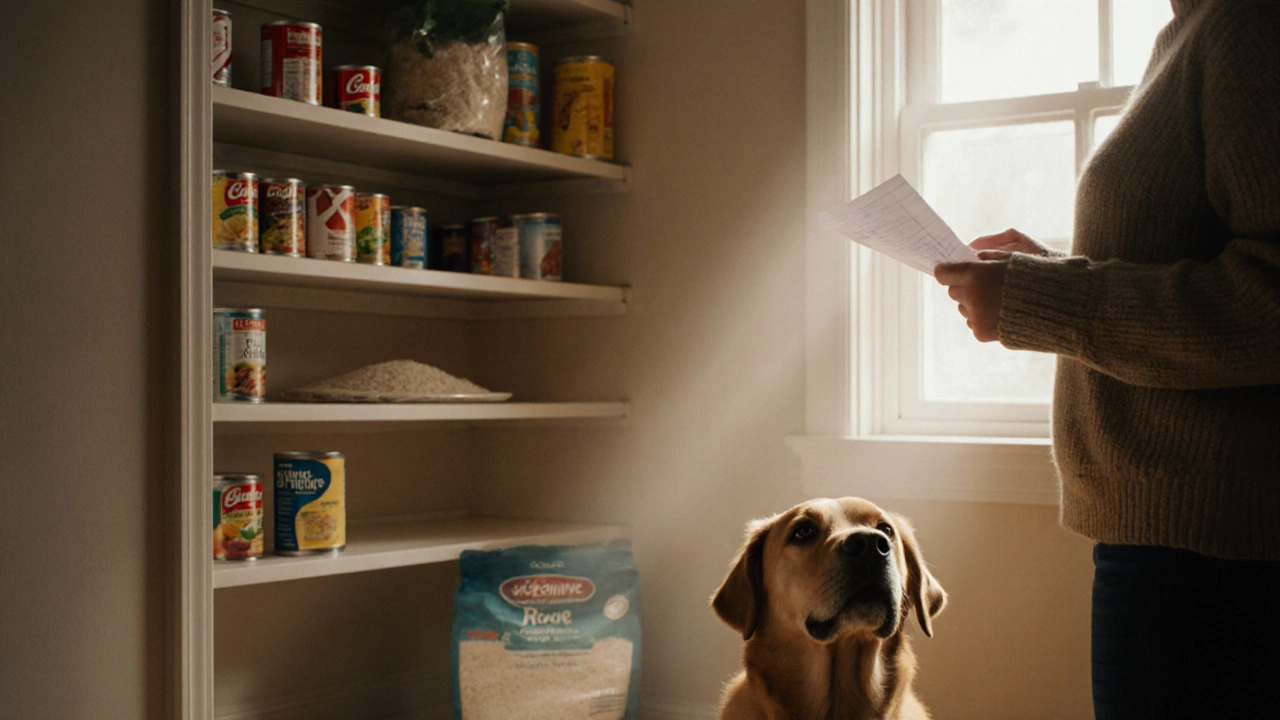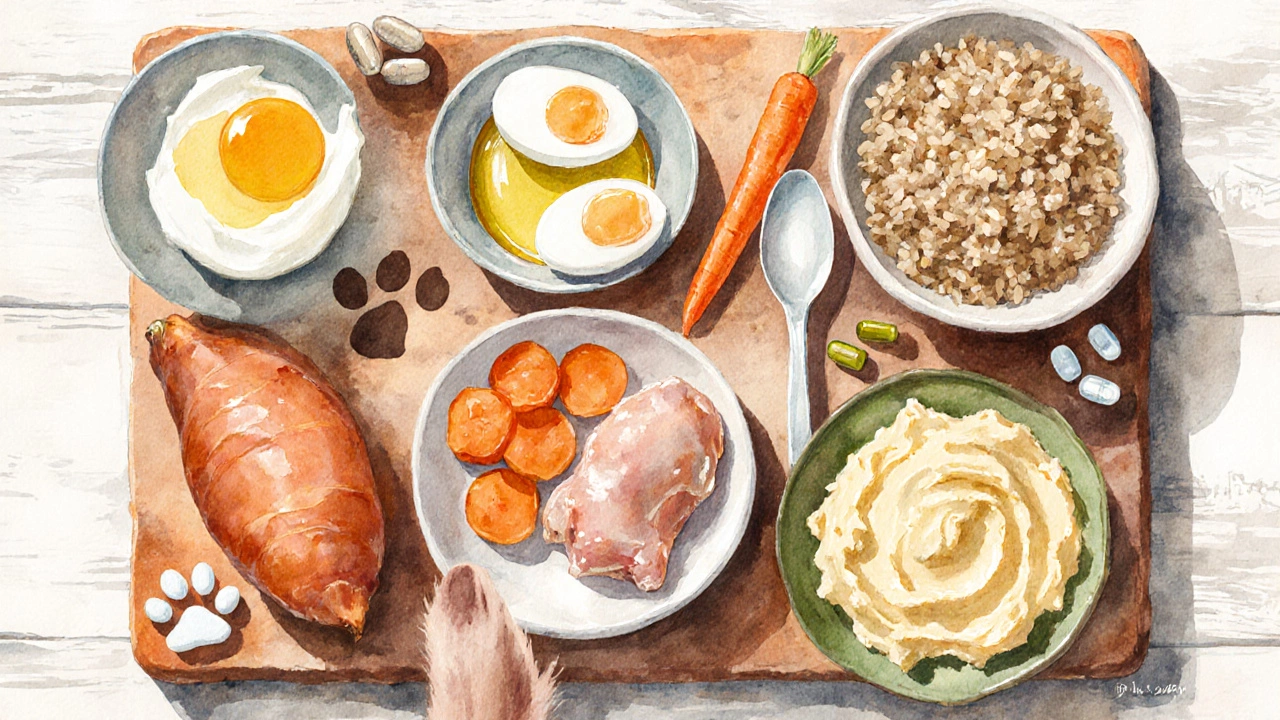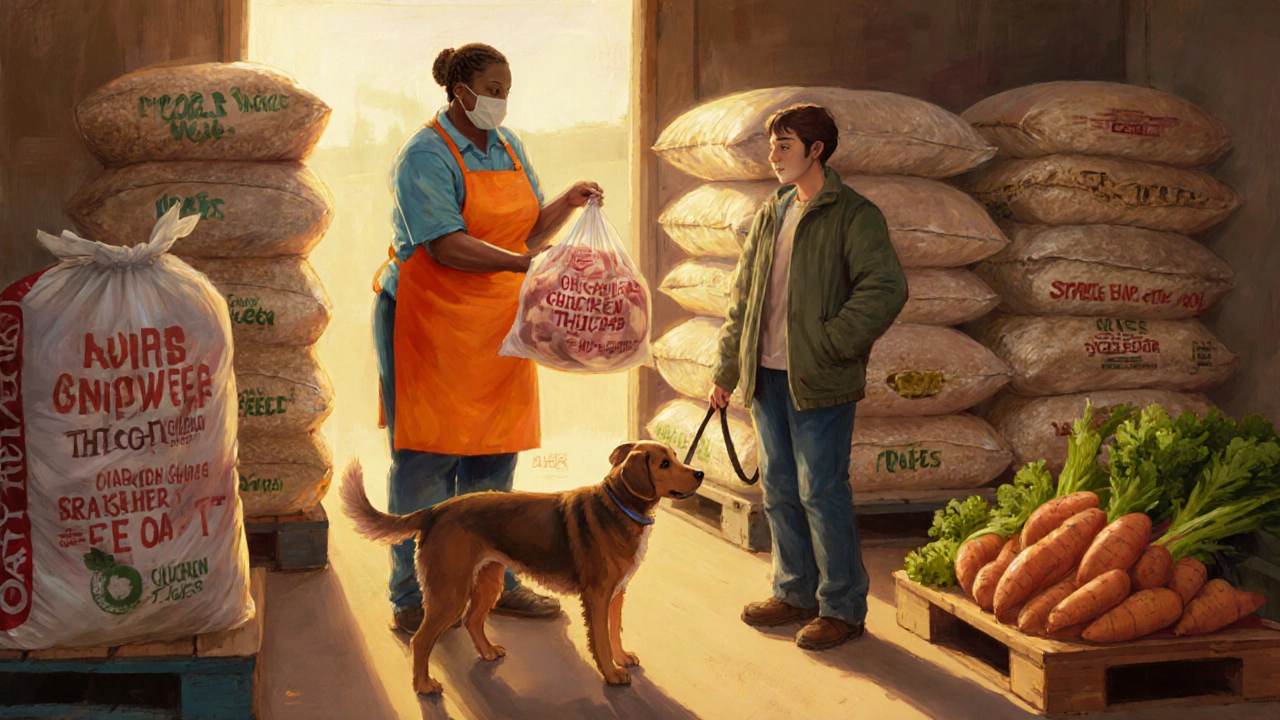
Dog Food Budget Calculator
Budget Calculator
Meal Plan Results
When the pantry is light and the bill for premium kibble is too high, many dog owners wonder what to do next. Dog food is a commercial product designed to meet a dog's nutritional needs, but it isn’t the only way to keep a canine healthy. Below you’ll find a straight‑forward plan that lets you feed a balanced diet without breaking the bank, using foods you probably already have at home or can buy cheap at a local store.
Understanding Basic Dog Nutrition
Before you start mixing meals, it helps to know the three pillars of Dog nutrition the combination of protein, fat, and carbohydrates that supports a dog's growth, energy, and organ function. Dogs need:
- Protein - the building blocks for muscle, skin, and immune health.
- Fat - a dense energy source and carrier for fat‑soluble vitamins.
- Carbohydrates - quick energy and fiber for digestion.
Vitamins and minerals (calcium, phosphorus, zinc, etc.) complete the picture, but you can meet most of those by using a variety of whole foods and a sprinkle of a cheap supplement if needed.
Cheap Protein Sources You Can Find Anywhere
Protein is the most critical and often the most expensive component of a dog’s diet. Luckily, a few inexpensive animal proteins deliver the amino acids dogs crave.
| Protein | Average Cost (NZD/lb) | Protein % (dry weight) | Comments |
|---|---|---|---|
| Chicken thighs (skin‑on) | 2.20 | 24 | Rich in flavor; trim excess fat if dog is overweight. |
| Canned tuna in water | 2.80 | 23 | Watch for mercury; limit to a few meals per week. |
| Eggs (large) | 0.30 each (~0.70/lb) | 13 | Excellent source of vitamins; scramble or boil. |
| Ground turkey (93% lean) | 2.50 | 22 | Low‑fat; cook thoroughly to kill pathogens. |
| Beef liver | 4.00 | 20 | Very nutrient‑dense; feed in small amounts. |
All of these proteins can be bought in bulk, frozen, and portioned out for a week’s worth of meals. Cook them simply - boil, bake, or grill - and avoid any seasoning that could upset a dog’s stomach (no garlic, onion, or excessive salt).
Affordable Carbohydrate and Fiber Staples
Carbs aren’t strictly essential for dogs, but they add calories and keep the stool regular. Cheap options include:
- Brown rice - a gentle grain that’s easy to digest.
- Oatmeal - soluble fiber that helps with digestion.
- Sweet potatoes - high in beta‑carotene and fiber.
- Carrots - low‑calorie crunch for dental health.
These can be cooked in bulk, mashed, and stored in the fridge for up to four days or frozen for longer periods.

Adding Healthy Fats Without Going Overboard
Fat supplies energy and supports skin and coat health. When money is tight, you can use these budget‑friendly fats:
- Plain yogurt (unsweetened) - adds calcium and probiotics.
- Cottage cheese - inexpensive and rich in casein protein.
- Olive oil - a spoonful per day adds essential omega‑9s.
- Fish oil capsules - look for bulk sales; a few capsules a week boost omega‑3s.
Keep total added fat to about 10 % of the meal’s calories to avoid weight gain.
Sample 7‑Day Budget Meal Plan
Below is a simple rotation that hits protein, carbs, and fat while staying under ~NZD 5 per day for a medium‑size dog (≈20 lb). Adjust portions based on your dog’s weight and activity level.
- Day 1 & 2: 150 g boiled chicken thigh (skin removed), 100 g cooked brown rice, 30 g steamed carrots, ½ tsp olive oil.
- Day 3 & 4: 120 g scrambled eggs (2 eggs), 80 g mashed sweet potato, 30 g plain yogurt.
- Day 5 & 6: 130 g ground turkey, 90 g oatmeal (cooked), 30 g peas (frozen, thawed), ½ tsp fish oil.
- Day 7: 100 g canned tuna (drained), 100 g quinoa (optional - if you can find a cheap bulk bag), 30 g cottage cheese.
Mix each meal thoroughly, serve at room temperature, and always provide fresh water.
Safety Tips When Feeding Human Foods
Feeding from the kitchen saves money, but a few rules keep your pup safe:
- No onions, garlic, chives, or leeks - they damage red blood cells.
- No grapes, raisins, or macadamia nuts - toxic to dogs.
- Avoid raw meat unless you’re comfortable handling pathogens; cooking eliminates most risks.
- Limit dairy if your dog is lactose intolerant; watch for stools.
- Never add salt, sugar, or artificial sweeteners (especially xylitol).
If you’re ever in doubt, a quick call to your vet (many offer free advice for budget concerns) can clear up uncertainties.

Finding Discounts and Free Resources
Even on a shoestring, you can stretch your budget further by tapping into community resources:
- Pet food banks - many shelters run food banks for low‑income owners.
- Supermarket clearance aisles - look for near‑expiry meat cuts; freeze immediately.
- Bulk club memberships - buying rice, oats, and frozen meat in 25 kg bags pays off over a year.
- Local farms - sometimes offer “seconds” (imperfections) at a discount.
- Online community groups - neighborhood Facebook or Nextdoor pages often have free or cheap leftovers.
Combine these savings with the homemade plan above, and you’ll have a reliable, nutritious feeding routine without relying on pricey kibble.
Key Takeaways
- Focus on inexpensive protein sources like chicken, tuna, eggs, and turkey.
- Add cheap carbs and fiber - brown rice, oatmeal, sweet potatoes, carrots.
- Include modest healthy fats via plain yogurt, cottage cheese, olive oil, or fish oil capsules.
- Follow safety rules: avoid toxic foods, cook meat thoroughly, watch for dairy intolerance.
- Leverage community discounts, food banks, and bulk buying to keep costs low.
With a bit of planning, you can give your dog a balanced diet that’s kind to both their belly and your wallet.
Frequently Asked Questions
Can I feed my dog only homemade meals?
Yes, as long as the meals are balanced for protein, fat, carbs, and include a source of calcium and essential vitamins. Using a simple recipe source or a vet‑approved supplement can ensure completeness.
How much protein does a medium‑size dog need daily?
A healthy adult dog should get about 18-25 % of calories from protein. For a 20‑lb dog eating 800 kcal per day, that’s roughly 144‑200 kcal from protein, or about 35‑45 g of animal protein.
Is it okay to use human‑grade fish oil for my dog?
Yes, as long as the fish oil is pure, free of additives, and you follow the dosage recommendations (generally 20 mg EPA + DHA per pound of body weight).
What are the signs my dog isn’t getting enough nutrients?
Watch for a dull coat, excessive shedding, lethargy, frequent infections, or weight loss despite eating. Any of these symptoms merit a vet check‑up.
Can I add a multivitamin to a homemade diet?
A basic canine multivitamin can fill gaps, especially calcium and phosphorus. Choose one without added herbs or unnecessary calories.
How do I store bulk‑cooked meals safely?
Cool the food quickly, portion into airtight containers, and freeze for up to three months. Thaw in the fridge overnight before serving.
Is it okay to feed my dog leftovers from my own plate?
Occasionally, yes-provided the food is plain, unseasoned, and free from toxic ingredients. Too many table scraps can upset the balance and lead to weight gain.




